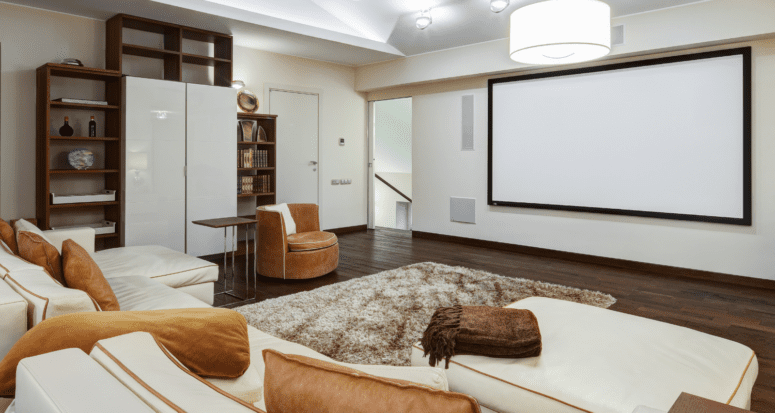Lights, Camera, Appraisal: Can a Home Theater Make Your Property More Valuable?
- Published on
- 5 min read
-
 Melissa Rudy Contributing AuthorClose
Melissa Rudy Contributing AuthorClose Melissa Rudy Contributing Author
Melissa Rudy Contributing AuthorMelissa Rudy is a seasoned digital journalist with 15 years of experience writing web copy, blog posts and articles for a broad range of companies. When she can’t buy or sell homes, she settles for the next-best thing: researching and writing about all things real estate-related.
PJs on, popcorn in the microwave, and something binge-worthy lighting up the small screen: This is how many of us have found comfort and sanity during a global pandemic, creating broadened appeal for a home theater or dedicated media room. In fact, 70% of Americans have enjoyed shows and movies as their go-to hobby since the start of the lockdown.
With Regal Movie Chain announcing the close of all of its 536 U.S. theaters in October 2020 — and many consumers skittish about venturing out even after theaters have reopened — the stage is set for home theaters becoming a lasting perk for homebound families. But does adding a dedicated media room increase a home value? We put the theory to the test. Hear what an experienced real estate agent and home appraiser say you can get back on this specialized home upgrade (besides an amazing night in!)

What makes a room a ‘home theater?’
Most homes have a designated space for people to gather and watch movies, shows, and games, even if it’s just a living room or family room with a couple of couches and a TV. But there are certain characteristics that qualify a room as an “official” home theater:
A separate, enclosed space:
Morris Lucas, a top agent in Indianapolis, often sees home theaters as part of a finished basement. Theaters can be located anywhere in the house, though, as long as it’s not a “pass-through” room where people could potentially disrupt viewings. Some experts recommend using a space that is at least 15 feet wide and 20 feet long. Basements work well because they don’t have to compete with as much natural light, but you can also make do with blackout blinds.
Theater-style seating and special upgrades:
Lucas recently sold a house that had a media room with theater-style seating, where curved rows of leather chairs provided comfort along with a prime viewing angle. Some upscale theater seats might also include features like:
- Power reclining
- Headrests and lumbar support
- LED lighting
- Built-in storage
- Tray tables and cup holders
- Heat and massage built into the chairs
Display device:
The display device is the visual focal point of a home theater. Some people use a large, flat-panel LCD or plasma television, but others go with a projector and screen. The display should be positioned at an optimal viewing distance from the seating area.
Sound system:
The hub of the home theater system is the receiver, which connects the display device, the speakers, and the video input. Many receivers double as sound amplifiers. Surround sound speakers are commonly used in home theaters to create a more immersive cinema-like experience.
Source components:
Most of today’s home theaters use Blu-ray players as a video source but many also include a cable box or receiver to stream content from a media service (Netflix and Hulu have accounted for 25% of consumers’ TV-watching time since the pandemic began).
Lighting:
For optimal viewing, a home theater should have the capability for complete darkness. However, those enjoying the room should be able to flip on lighting as needed, ideally via recessed overhead lighting with a dimming function.
Bar area:
Although not a requirement, many higher-end home theaters include some sort of bar area, refreshment station, or even a popcorn machine.
How much does it cost to put in a home theater?
While kitchens and bathrooms are must-have spaces, home theaters are more of a “nice-to-have” rather than a need. It might seem like they’d be more likely to appear in high-end, luxury homes, but plenty of mid-range properties have them as well. In fact, budget-minded homeowners may choose to install a media room as a cost-effective alternative to spending money at movie theaters.
As far as the cost to put in a home theater, you’ll find a wide range of price points. Thumbtack estimates the national average expense at between $2,000 to $33,000 and can include audio and video components, seating, electrical work, lighting, and professional installation.
A multitude of factors impact the total price tag, starting with the space itself. If the homeowner has to finish off a room, put up walls, or renovate a space, that will make the project far more expensive than if they are turning an existing room into a home theater. The quality of the system and furnishings also drives the cost.
Thumbtack offers a breakdown of what types of home theaters you can get at different price points:
- For $2,000, a homeowner might purchase a 60-inch TV and small home system that includes five box speakers and a subwoofer and a surround amp.
- A $6,000 home weather might include a Dolby Surround 7.1 system with an 80” UHDTV, seven surround speakers, and one subwoofer.
- For $13,000, a homeowner could purchase a projector and a 110-inch screen system with wireless speakers, a surround amp, a subwoofer, and audio wiring throughout the entire home.
- At $33,500, an upscale home theater might include a high-performance projector, a 130-inch Innovations Black Diamond screen, Dolby Atmos surround sound, and a remote-controlled lens kit for the projector.
How do home theaters impact property values?
Just as the cost of home theaters ranges dramatically, so does the potential impact of a home theater on property value.
Laura Snyder, a top Baltimore real estate agent, has sold many properties with home theaters. In her experience, appraisers’ opinions on the value of these rooms aren’t consistent. She has seen some appraisers give a certain value for just the finished space, but not the equipment or theater itself. Others have adjusted the value for the theater, but only if it has raised seating. Overall, it’s a subjective and unpredictable assessment.
When pricing a home for sale, Snyder might take a home theater into account if it’s a high-end installation that has all the bells and whistles, but she doesn’t automatically attribute a certain price boost anytime there’s a media room. “Just as appraisers don’t have specific number adjustments for a home theater, I don’t use a set number when pricing a home that has one,” she says.
Snyder believes that when investing in a home theater, the homeowner shouldn’t expect to get back an amount equivalent to what they spent. “They’re paying for the experience and the personal enjoyment, not for the return at resale,” she explains.
Lucas agrees that a home theater doesn’t always add value to a home. He compares it to having a swimming pool: It might be attractive to certain buyers, but it can also potentially limit who is interested in the home, as someone who doesn’t need or want a home theater might prefer to have an open space to use as a bedroom, office, or some other application.
The value of a home theater from an appraiser’s lens
Edward Bedinotti, a New York State-certified residential appraiser, says there are many factors that determine whether a home theater will add value:
- If a room in the house has been set up to function as a home theater, Bedinotti says the value would be attributed to the gross living area of the room.
- If the home theater is part of a finished basement, the appraiser could either value the theater as a finished below-grade room, or could value it as a finished below-grade area based on the total finished below-grade square footage. Typically, the market isn’t paying the same amount for a finished basement area, but there are times when the area could be valued the same as the above-grade gross living area.
- If the “home theater” is a separate building, the appraiser could attribute value to it as a line item adjustment and could again value the area with a lump adjustment for the amenity, or the appraiser could value the square footage area of the space for the amenity. “Ultimately, it would also depend on whether the setup of the property conforms to what is common and typical in the market area and value range,” adds Bedinotti.
- While it’s difficult to quantify whether home theaters are driving a specific dollar increase in home value post-pandemic, it stands to reason that homeowners would be more inclined to use such a space without the option of outside entertainment. That said, with more people working and schooling at home during COVID, there’s a chance that they would place a higher value on having space for a home office, student workspace, or playroom rather than a home theater.

Tips to maximize the value of a home theater
If you’re planning on putting in a home theater or already have one in place, there are some strategies to maximize your own enjoyment of the space while making it more appealing to buyers when it comes time to sell:
- Keep up with latest and greatest technology: Snyder recommends using the most up-to-date equipment and improvements to make the room more of a selling point. Lucas agrees, noting that most home theaters become outdated within a five-year period. For example, a 7200-pixel or 1080-pixel television might have been perfectly suitable at one time, but these days, screens larger than 40 inches are usually only available in the higher-performance 4K Ultra HD.
- Showcase it during showings: When you sell a house with a home theater, make sure to have it open, staged, and playing a movie (with low volume) during showings so buyers can get a sample of the experience.
- Avoid any irreversible renovations: To reduce the risk of alienating a segment of buyers, try to design the space so that it could be retrofitted for a different use — like a bedroom, office, or playroom — if possible.
- Include the components with the sale. If you don’t plan to include all of the audio and video components, seating, or other elements when selling, your agent should not market the space as a home theater.
Bottom line: Are home theaters worth it?
Sci-fi fanatics, history buffs, and romantic comedy indulgers alike might think of a home theater as a cool feature. But real estate agents and appraisers seem to agree that the value of a home theater is subjective and rarely straightforward.
If you plan to add a media room to your home, the decision should be largely fueled by your own personal enjoyment of the space rather than a dollar-by-dollar return on investment.
Similar to backyard swimming pools and other specialized amenities, some buyers might see a home theater as a waste of space that could be used for a more practical purpose, but other buyers will actively seek out homes with built-in theaters and may be willing to pay a premium for a show-stopping space dedicated to entertainment.
Header Image Source: (Artserstudio / Shutterstock)
